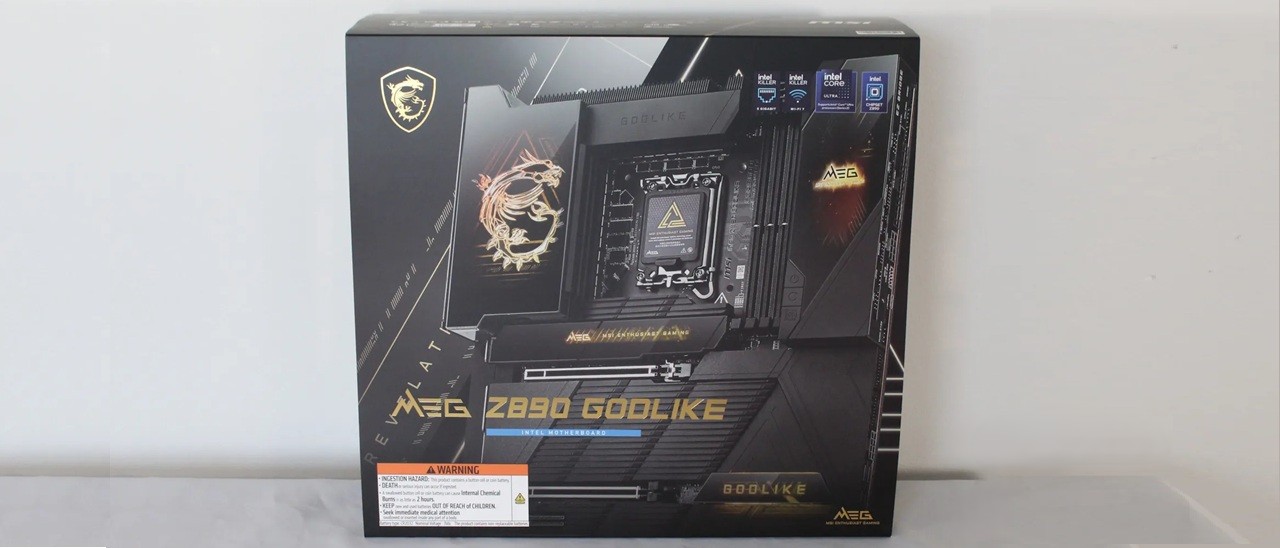Tom's Hardware Verdict
Arguably the most well-equipped motherboard for Intel’s latest platform, the Z890 Godlike has everything you would expect from a flagship-class board (and then some), including an almost mythological price point exceeding $1,300.
Pros
- +
Seven rear Type-C ports
- +
Thunderbolt 5 AIC included
- +
Incredibly robust power delivery
- +
Eight total M.2 (four 5.0)
- +
Click BIOS X
Cons
- -
That price, though…
Why you can trust Tom's Hardware
Motherboards come in all shapes, sizes, and price points. Over the years, and through this latest generation for Intel, we have reviewed dozens of models, ranging from Mini-ITX to E-ATX and from sub-$100 to over $1,000. Today, we’re on the high end of the spectrum—the highest, actually—with the MSI MEG Z890 Godlike. Priced at $1,329, it’s the most expensive consumer-focused motherboard I can remember. This flagship model features top-of-the-line components and boasts a premium appearance, making it the perfect centerpiece for your showcase build.
Hardware-wise, you do get the best of the best, including the most robust power delivery for the platform, 10 GbE and Wi-Fi 7, a premium audio solution with an integrated DAC, ample storage with eight M.2 sockets (M.2 Xpander-z Slider Gen 5), a Thunderbolt 5 card, and an EZ Control Hub for fans and lighting. If you sift through the additional details, you’re almost certain to find the kitchen sink. In addition to the hardware, you get MSI’s updated Click BIOS X and several “EZ” features, including EZ Link and Ai Overclocking.
Below, we’ll examine the board's details and determine whether it deserves a spot on our Best Motherboards list. However, before we share the test results and discuss the details, the specifications from MSI’s site are listed below.
Specifications of the MSI MEG Z890 Godlike
Socket | Intel LGA 1851 |
Chipset | Z890 |
Form Factor | ATX |
Voltage Regulator | 30 Phase (26x 110A SPS MOSFETs for Vcore) |
Video Ports | (2) Type-C DisplayPort (v2.1) |
USB Ports | (1) Thunderbolt 4 (40 Gbps) Type-C |
| Row 6 - Cell 0 | (1) USB 3.2 Gen 2x2 (20 Gbps) Type-C |
| Row 7 - Cell 0 | (5) USB 3.2 Gen 2 (10 Gbps) Type-C |
| Row 8 - Cell 0 | (8) USB 3.2 Gen 2 (10 Gbps) |
Network Jacks | (1) 10 GbE |
| Row 10 - Cell 0 | (1) 5 GbE |
Audio Jacks | (2) Analog + SPDIF |
Legacy Ports/Jacks | ✗ |
Other Ports/Jack | ✗ |
PCIe x16 | (1) v5.0 (x16/x8) |
| Row 15 - Cell 0 | (1) v5.0 (x8) |
PCIe x8 | ✗ |
PCIe x4 | (1) v4.0 (x4) |
PCIe x1 | ✗ |
CrossFire/SLI | ??? |
DIMM Slots | (4) DDR5-9200+(OC)*, 256GB Capacity |
| Row 21 - Cell 0 | 1DPC 1R Max speed up to 9200+ MT/s |
| Row 22 - Cell 0 | 1DPC 2R Max speed up to 7200+ MT/s |
| Row 23 - Cell 0 | 2DPC 1R Max speed up to 6400+ MT/s |
| Row 24 - Cell 0 | 2DPC 2R Max speed up to 5600+ MT/s |
| Row 25 - Cell 0 | *Depends on CPU |
M.2 Sockets | (2) PCIe 5.0 x4 (128 Gbps) / PCIe (up to 80mm) |
| Row 27 - Cell 0 | (2) PCIe 4.0 x4 (64 Gbps) / PCIe (to 80mm) |
| Row 28 - Cell 0 | (1) PCIe 4.0 x4 (64 Gbps) / PCIe (to 80mm) |
| Row 29 - Cell 0 | (1) PCIe 4.0 x4 (64 Gbps) / PCIe + SATA (to 80mm) |
| Row 30 - Cell 0 | Via M.2 Xpander-Z Slider |
| Row 31 - Cell 0 | (2) PCIe 5.0 x4 (128 Gbps) / PCIe (up to 80mm) |
| Row 32 - Cell 0 | Supports RAID 0/1/5/10 |
SATA Ports | (4) SATA3 6 Gbps |
| Row 34 - Cell 0 | Supports RAID 0/1/5/10 |
USB Headers | (1) Thunderbolt 4 (40 Gbps) Type-C |
| Row 36 - Cell 0 | (1) USB v3.2 Gen 2x2 (20 Gbps) Type-C |
| Row 37 - Cell 0 | (2) USB v3.2 Gen 1 (5 Gbps) |
| Row 38 - Cell 0 | (2) USB v2.0 (480 Mbps) |
Fan/Pump Headers | (10) 4-Pin (CPU, Combo, System fans) |
RGB Headers | (3) aRGB Gen 2 (3-pin) |
| Row 41 - Cell 0 | (1) RGB LED (4-pin) |
Diagnostics Panel | (1) Dynamic Dashboard III |
| Row 43 - Cell 0 | (1) EZ Digit Debug LED |
Internal Button/Switch | Power, Reset, EZ PCIe Release |
SATA Controllers | ✗ |
Ethernet Controller(s) | (1) Marvell AQC113CS (10 GbE) |
| Row 47 - Cell 0 | (1) Intel Killer E5000 (5 GbE) |
Wi-Fi / Bluetooth | Intel Killer BE1750x Wi-Fi 7 2x2- 320 MHz, 6 GHz, BT 5.4, 5.8 Gbps |
USB Controllers | (1) Realtek RT5420 |
| Row 50 - Cell 0 | (1) Realtek RT5429E |
| Row 51 - Cell 0 | (1) Genesys Logic GL850 |
| Row 52 - Cell 0 | (1) Genesys Logic GL3523 |
HD Audio Codec | Realtek ALC4082 + ESS9219Q Combo DAC/HPA |
DDL/DTS | ✗ / ✗ |
Warranty | 3 Years |
Inside the Box…
Inside the large motherboard box, you'll find a bunch of extras. Some, like the M.2 Xpander-z Slider Gen5 card, Thunderbolt 5 card, and the Wi-Fi antenna, are snug in foam padding. The rest—cables, stickers, guides, and whatnot—are packed in a separate box.
- M.2 Xpander-z Slider Gen5 AIC
- Thunderbolt 5 AIC
- EZ Control Hub
- USB drive (drivers)
- EZ Wi-Fi Antenna
- EZ M.2 Clips II Remover
- 1 to 3 ARGB G2 extension cable
- 1 to RGB extension cable
- 1 to 3 EZ Conn-Cable (V2)
- EZ Link Cable
- EZ Control Hub SATA power cable
- M.2 Xpander card fan control cable
- Thunderbolt 5 header cable
- EZ Front Panel cable
- (4) SATA cables
- (2) Thermistor cables
- M.2 Xpander card thermal pads
- M.2 screw and standoff set
- EZ Control Hb screw seets
- Cable stickers
- Flyer/installation guide/EU regulatory notice
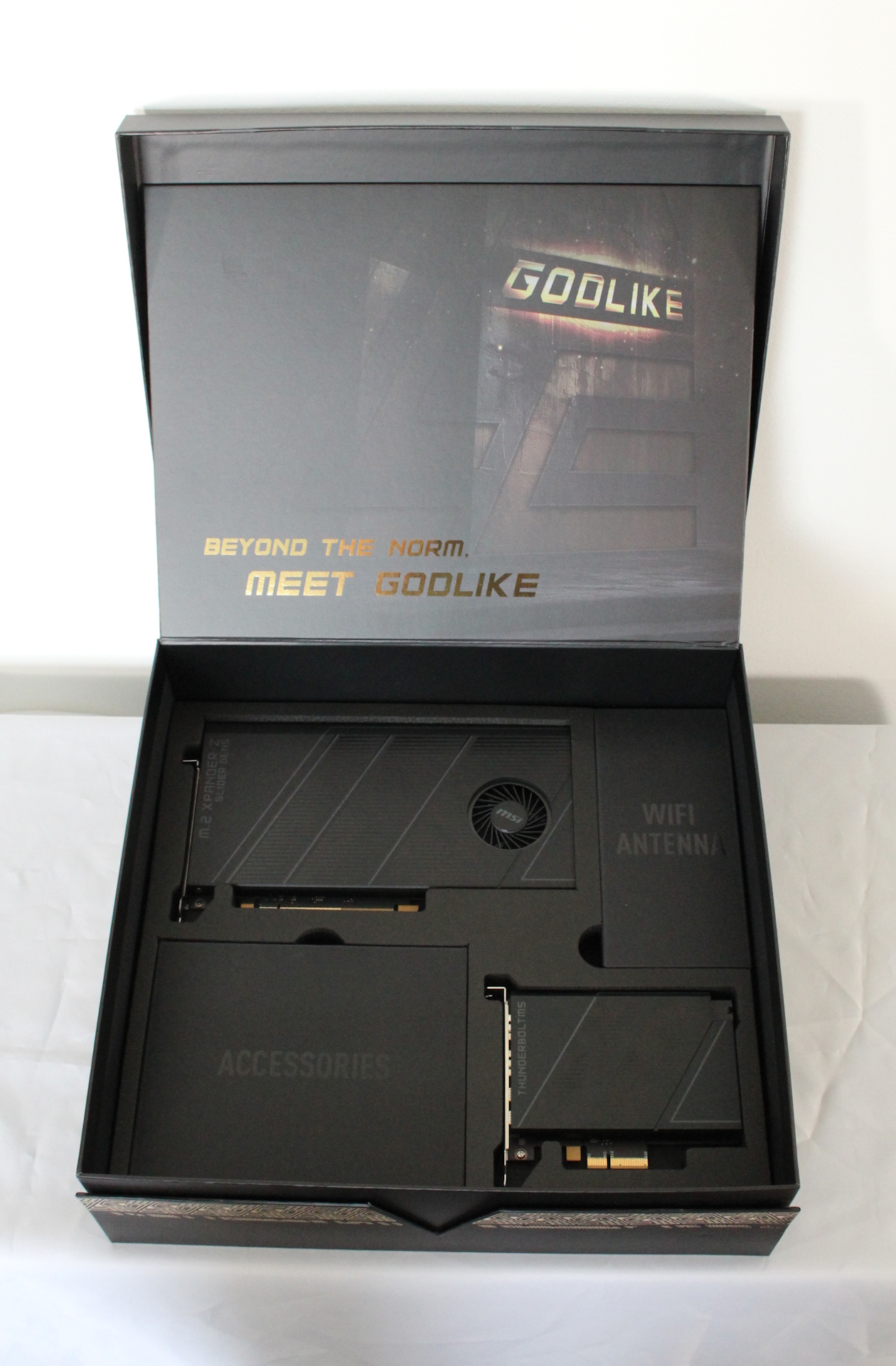
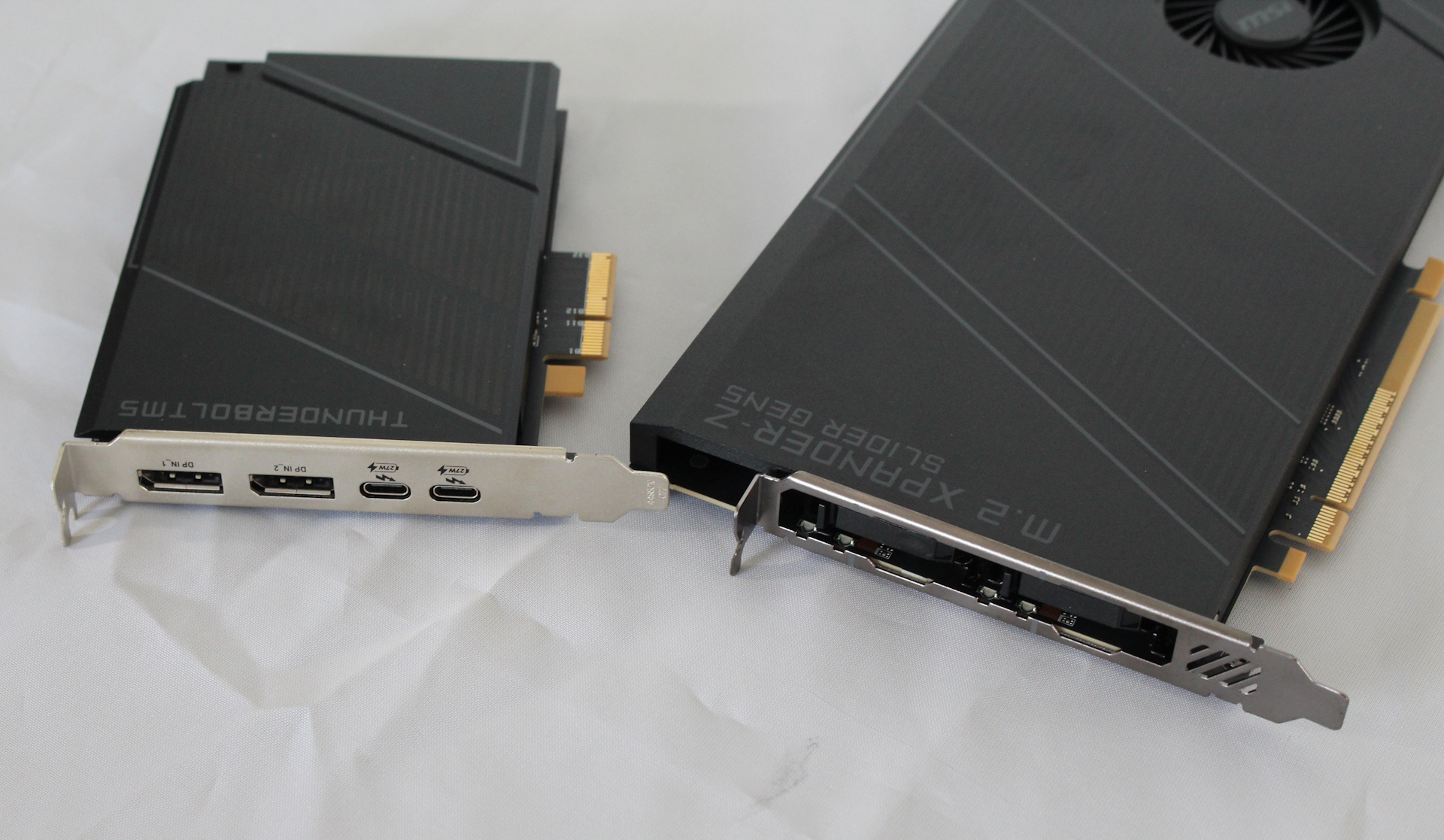
Design of the Z890 Godlike
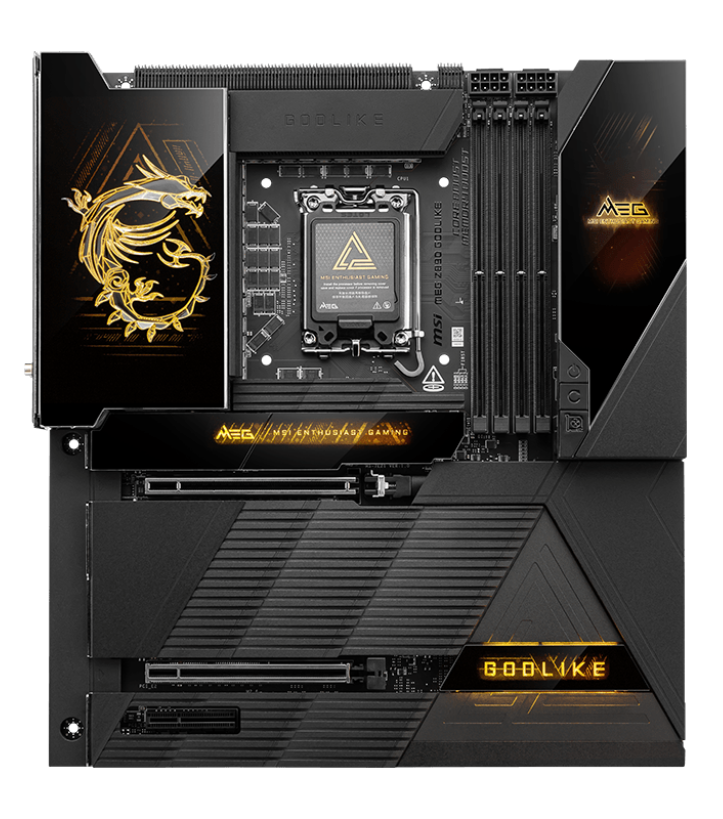
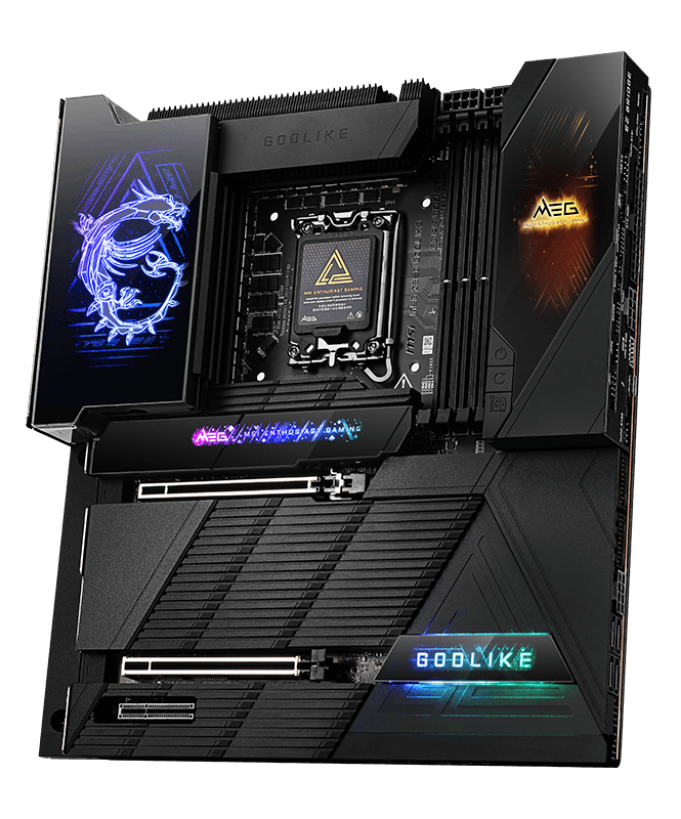
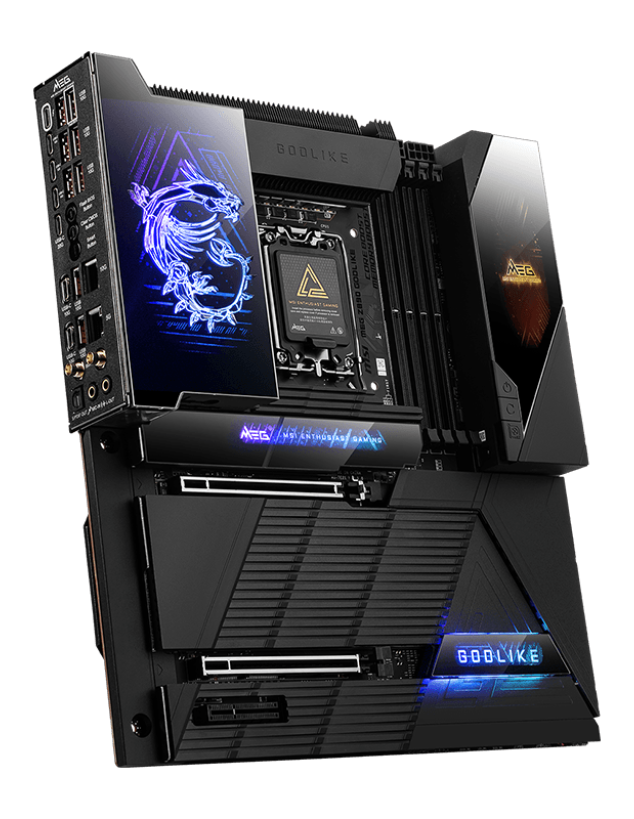
The Z890 Godlike certainly looks the part of a flagship motherboard. Nearly all of the matte-black 10-layer PCB is covered by shrouds and heatsinks or the EZ Bridge. On top of the VRM heatsink is one of three RGB features, this one sporting the MSI Dragon. On top of the EZ Bridge is a 3.99-inch full-color TFT offering several features, including real-time hardware monitoring, troubleshooting, BIOS update status, and clock display. You can also personalize it with your own image.
The bottom is covered in plate-style heatsinks with a powder-coat finish, along with grooves for increased thermal dissipation. The top M.2 heatsink and chipset also feature RGB lighting. Overall, the board exudes a premium vibe, and the all-black look is sure to blend in with most builds, while the Dynamic Dashboard III feature sets it apart from others.
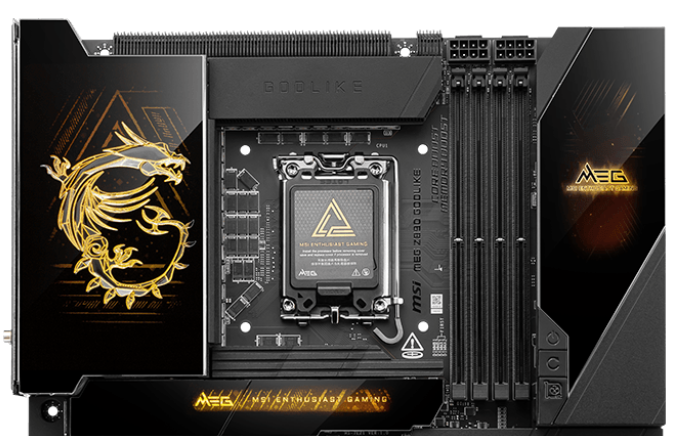
Focusing on the top half of the board, we gain a clearer view of the RGB feature and the VRM heatsink, which features a wavy fin design and a direct-touch cross-heatpipe. This design, in part, comprises the Frozr design, which also includes the backplate, thermal pads, and other components. There’s plenty of mass and surface area to keep the high-end power delivery components running cool, no matter which processor and what overclock you’re using.
Get Tom's Hardware's best news and in-depth reviews, straight to your inbox.
To the right of the CPU socket are four DRAM slots with a locking mechanism on the bottom side only. MSI lists support for up to 256GB of DDR5 RAM with speeds up to 9200+ MT/s. We had no issues running our DDR5-8200 kit during testing, and I’m sure the board will reach advertised speeds with the proper kit and chip.
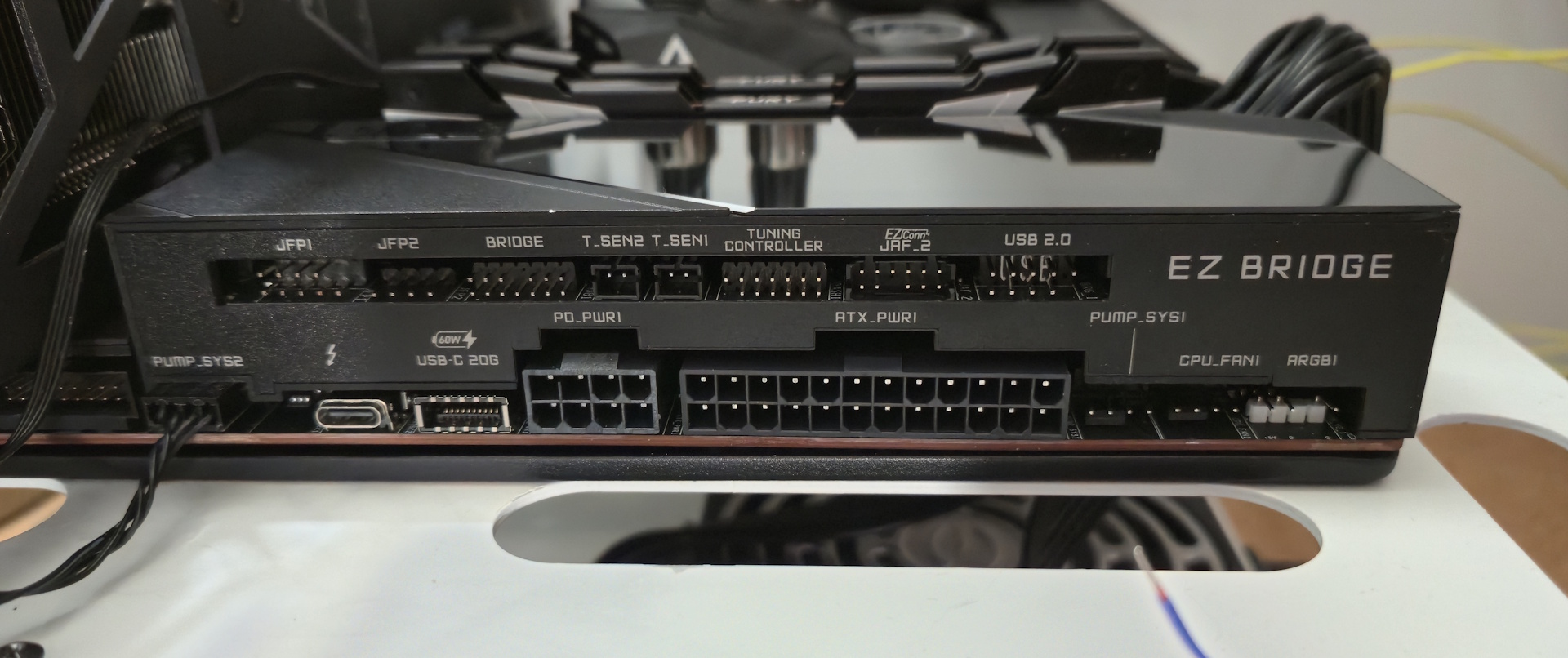
MSI’s EZ Bridge consolidates multiple headers and connectors into a single area. With all headers on one side, it creates a more organized cluster of cables, as opposed to having them scattered across the board. At the top are the two front-panel headers, the hub connection, dual 2-pin thermistor headers, tuning controller header, EZConn header, and a USB 2.0 header. At the bottom, there are a total of three fan headers, an ATX and PD Power Connector (up to 60W for the motherboard), a front-panel 20 Gbps USB Type-C header, and an additional Type-C connector for front-panel Thunderbolt 4 support.
For most users, the three available 4-pin fan headers won’t be sufficient. But don’t fret, as MSI includes the EZ Control Hub with seven additional fan headers, a 3-pin water flow header, two 3-pin ARGB headers, and a single 4-pin RGB header. The Sys fan headers output 1A/12W, the CPU Fan header 2A/24W, and the two pump headers each output 3A/36W. If you find yourself short on power or headers, you may want to re-evaluate your needs. MSI's EZ Bridge streamlines cable management by grouping numerous headers and connectors on one side of the motherboard. This creates a concentrated (albeit busy) area for connections, which can be more organized than a scattered set of headers.
This consolidated section includes: two front panel headers, the hub connection, two 2-pin thermistor headers, a tuning controller header, an EZConn header, and a USB 2.0 header. Located along the bottom edge are three fan headers, an ATX and PD Power Connector (supporting up to 60W for the board), a front panel 20 Gbps USB Type-C header, and another Type-C connector enabling front panel Thunderbolt 4.
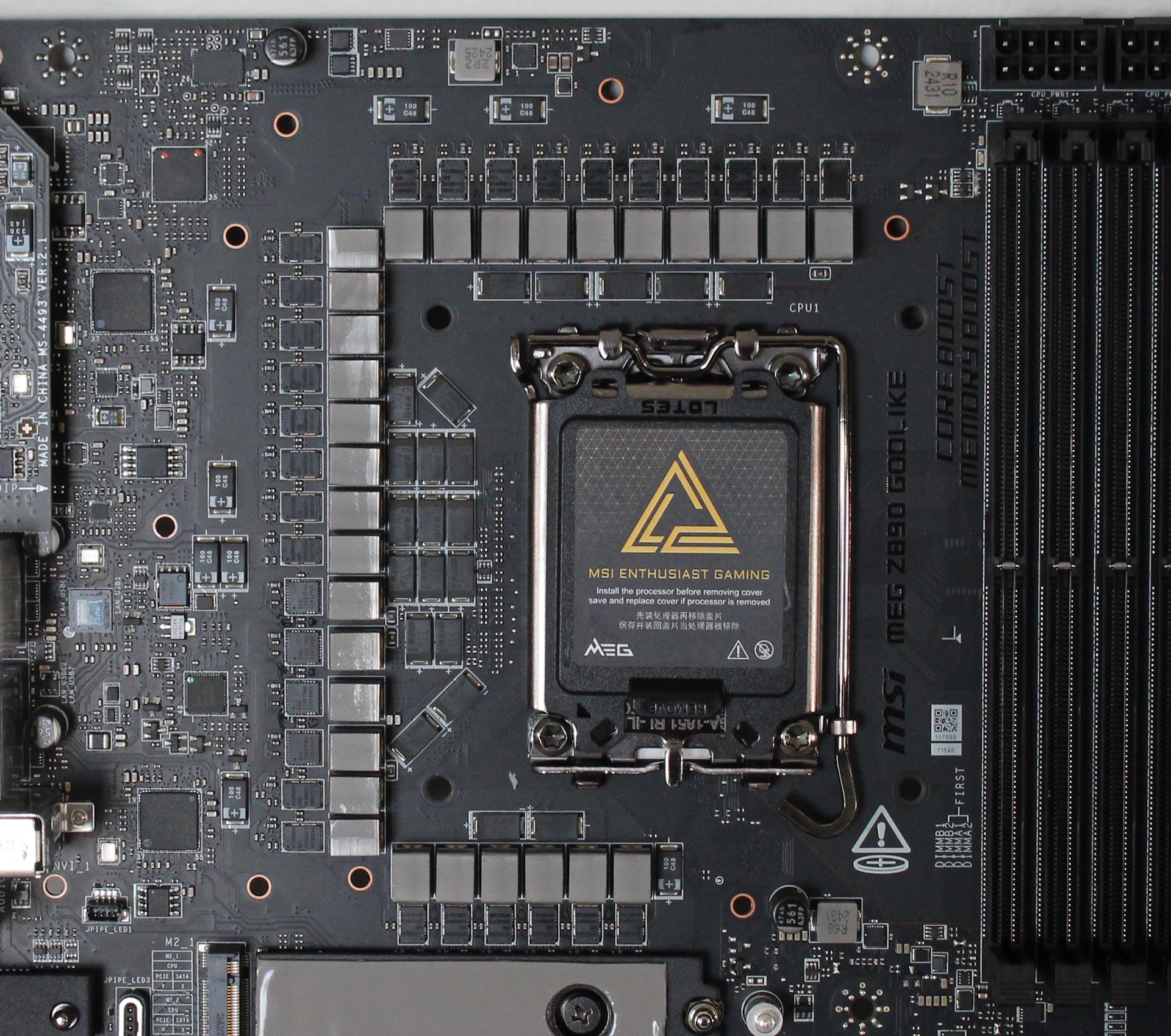
Power delivery on this board is one of the ‘Godlike’ features. Totaling a whopping 30 phases, MSI splits off 26 dedicated to Vcore. Power heads from the two 8-pin EPS connectors at the top of the board onto the Renesas RAA229131 PWM controller. Power then goes to the 26 Renesas R2209004 110A SPS MOSFETs in a Deut Rail configuration. Some napkin math yields 2,860A available to Vcore, which is enough to support any overclocking adventure, even sub-ambient sessions. You’ll get everything the chip will give you with this board.
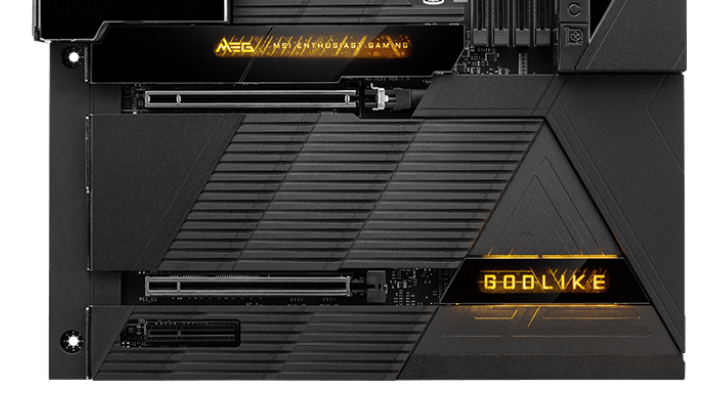
On the bottom half of the board, on the left and hidden under metal shrouds, is the flagship Realtek ALC4082 audio codec. Supporting the codec is the ESS9219Q DAC/HBA Combo. This is one of the best native audio solutions available; anything better will come from a discrete sound card.
In the middle of the board are two full-length PCIe slots and a single x4 slot. The top two slots are reinforced and PCIe 5.0-capable. The top slot supports up to PCIe 5.0 x16, while the bottom slot supports up to x8. Anytime the bottom slot is in use, the top slot drops to x8. When using the Xpander-x Slider Gen5 card in that slot, it splits to 5.0 x4/x4. If you have an M.2 drive in M.2_6, the second slot runs at 5.0 x4. You can configure the lanes in the BIOS (Advanced> PCIe Subsystem settings). Lastly, the bottom x4 slot operates at PCIe 4.0 speeds and connects directly through the chipset.
Hiding underneath plate heatsinks and one slightly larger heatsink are six M.2 sockets. M.2_1 hides under the RGB-topped heatsink and runs at PCIe 5.0 x4 (218 Gbps). M.2_2-5 are all PCIe 4.0 x4 (64 Gbps). M.2_5 also supports SATA- based M.2 modules. M.2_6 is unique, as it connects through the chipset and CPU, running up to PCIe 5.0 x4. If, somehow, these six M.2 sockets aren' t enough, the included M.2 Xpander-z Slider Gen5 card adds two more PCIe 5. 0 x 4- capable sockets. I like how the board separates the generally hot-running PCIe 5.0 M.2s, with the second on the bottom and not tucked directly under a video card.
Along the right edge are several more headers, including two 19-pin USB 3.2 Gen 1 (5Gbps) for USB, and another PCIe 6+2 pin for additional board/PCIe power. Next to that are the four SATA ports, a USB 2.0 header, and finally, the front-panel audio. If you're wondering where some connectivity is, it's probably along the right edge.
While an overwhelming majority of headers and connectivity run down the entire right edge, there are still some other headers and switches along the bottom. You'll find things like the TB 5 header, LED and BIOS switches, and even a couple for extreme overclocking. Below is a complete list, from left to right.
- Reset and Power jumpers
- Thunderbolt 5 header
- Dashboard/LED/BIOS switches
- TPM header
- Power LED 1
- Slow Mode/LN2
- Battery
- OC retry button connector
- Safe boot jumper
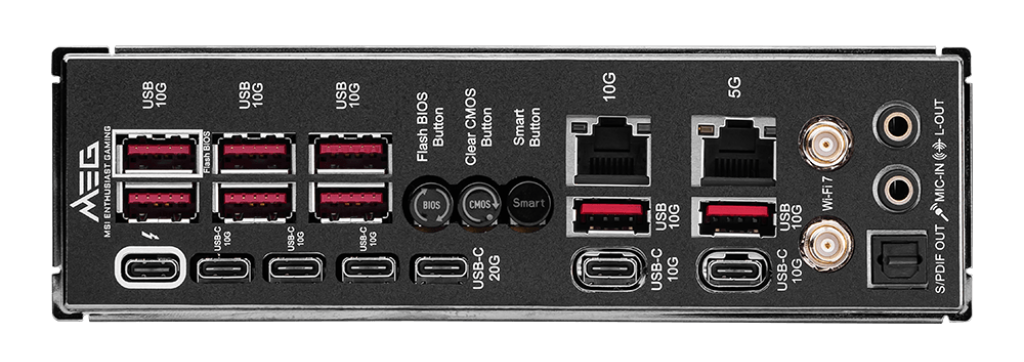
Looking at the rear IO, the first thing that jumped out to me is the copious number of USB ports. You can connect just about anything back here, including the fast Thunderbolt 4 (40 Gbps) Type-C. In the middle are three convenience buttons (Flash BIOS, Clear CMOS, Smart Button), Marvell 10 GbE and Killer 5 GbE ports, Killer-based Wi-Fi antenna connections, and last, the 2-plug plus SPDIF audio stack.
Although it’s not part of the rear IO the included Thunderbolt 5 accessory card adds even faster ports to the back of the PC. Boasting 160 Gbps transmission speeds (120/40) it’s the fastest port around. The two DisplayPorts support multiple 8K external displays and 27W charging power. What’s missing?
MORE: Best Motherboards
MORE: How To Choose A Motherboard
MORE: All Motherboard Content

Joe Shields is a staff writer at Tom’s Hardware. He reviews motherboards and PC components.
-
Energy96 Good review but probably should have reviewed the AMD version. Can’t imagine many people building a super high-end machine would choose Intel right now. The AMD version was also a little less expensive.Reply
I used the AMD version of this board with a 9950x3d and it’s awesome. No other board looks as good as this one, wish I could post up some pics but they just don’t do it justice. The board is a masterpiece and in a glass case with liquid cooling and all the animations and lcd screen it’s mind blowing. It’s pricy for sure but nothing else like it out there. Myself, I used the money I saved from a cancelled weekend trip to pay for it lol. Zero regrets, I could stare at it for hours. -
ITAngel Amazing, love the features listing for it.Reply
Personally, I would choose Intel, but I have my reasons, especially since I’ve previously owned both AMD Ryzen and Threadripper setups. My primary use is for creative work, so I really appreciated seeing a review of the Intel version. There are already so many reviews of the AMD versions online, so this was a refreshing change.Energy96 said:Good review but probably should have reviewed the AMD version. Can’t imagine many people building a super high-end machine would choose Intel right now. The AMD version was also a little less expensive.
I used the AMD version of this board with a 9950x3d and it’s awesome. No other board looks as good as this one, wish I could post up some pics but they just don’t do it justice. The board is a masterpiece and in a glass case with liquid cooling and all the animations and lcd screen it’s mind blowing. It’s pricy for sure but nothing else like it out there. Myself, I used the money I saved from a cancelled weekend trip to pay for it lol. Zero regrets, I could stare at it for hours. -
ITAngel Reply
I am assuming 3.5 or 5.25 drives? Dang I just aged myself. :rofl:!Kindaian said:But... but... but... It has no floppy disk controller! -
Energy96 Reply
It’s an amazing board in either version for sure.ITAngel said:Amazing, love the features listing for it.
Personally, I would choose Intel, but I have my reasons, especially since I’ve previously owned both AMD Ryzen and Threadripper setups. My primary use is for creative work, so I really appreciated seeing a review of the Intel version. There are already so many reviews of the AMD versions online, so this was a refreshing change.
It’s probably great for professional work but I would say this is mostly targeted to gamers who want a showpiece. I couldn’t imagine this locked away inside a closed case. Anything short of a full glass case with water cooling seems like a waste. I put it in an Antec C8 glass curve. That’s also a great case btw, well designed, very sturdy, and a lot better quality than its price would suggest. I was pleasantly surprised. Antec getting back into the game is good to see. -
drtweak I can see it now!Reply
"I picked up my PC and my BIOS just reset on its own!"
Why put a Clear CMOS button on the back?
"Was plugging in my new printer via USB and i had reset my BIOS"
lol -
Energy96 Reply
It’s there to allow for easier overlocking functionality without needing to open the case.drtweak said:I can see it now!
"I picked up my PC and my BIOS just reset on its own!"
Why put a Clear CMOS button on the back?
"Was plugging in my new printer via USB and i had reset my BIOS"
lol
The buttons are recessed into the IO plate and you need to hold it down for a duration to reset it. Not likely going to happen by accident. Do you usually pick up your PC by the IO plate? lol.
This feature is also found on many other boards btw. I’ve had several with it, usually boards targeted at overclocking. -
HardwiredWireless Reply
I think I would probably also choose Intel and I would use this generation if I were building a workstation and last generation if I were building a gaming rig. So far AMD has not come up with a processor that is better than one you can get from Intel.Energy96 said:Good review but probably should have reviewed the AMD version. Can’t imagine many people building a super high-end machine would choose Intel right now. The AMD version was also a little less expensive.
I used the AMD version of this board with a 9950x3d and it’s awesome. No other board looks as good as this one, wish I could post up some pics but they just don’t do it justice. The board is a masterpiece and in a glass case with liquid cooling and all the animations and lcd screen it’s mind blowing. It’s pricy for sure but nothing else like it out there. Myself, I used the money I saved from a cancelled weekend trip to pay for it lol. Zero regrets, I could stare at it for hours.
I think the name is kind of funny though It seems like if you truly were God-like you wouldn't need a computer at all. The fact that you need a computer belies you're God likeness.
